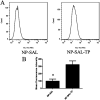GE11 Modified PLGA/TPGS Nanoparticles Targeting Delivery of Salinomycin to Breast Cancer Cells
- PMID: 34056977
- PMCID: PMC8182624
- DOI: 10.1177/15330338211004954
GE11 Modified PLGA/TPGS Nanoparticles Targeting Delivery of Salinomycin to Breast Cancer Cells
Abstract
Salinomycin (Sal) is a potent inhibitor with effective anti-breast cancer properties in clinical therapy. The occurrence of various side effect of Sal greatly limits its application. The epidermal growth factor receptor (EGFR) family is a family of receptors highly expressed in most breast cancer cells. GE11 is a dodecapeptide which shows excellent EGFR affinity. A series of nanoparticles derivatives with GE11 peptide conjugated PLGA/TPGS were synthesized. Nanoprecipitation method was used to prepare the Sal loaded nanoparticles at the optimized concentration. The characterization, targeting efficacy, and antitumor activity were detected both in vitro and in vivo. Encapsulation of Sal in GE11 modified PLGA/TPGS nanoparticles shows an improved therapy efficacy and lower systemic side effect. This represents the delivery system a promising strategy to enhance the therapeutic effect against EGFR highly expressed breast cancer.
Keywords: GE11; breast cancer; nanoparticles; salinomycin; targeting delivery.
Conflict of interest statement
Figures





Similar articles
-
Co-Delivery of Docetaxel and Salinomycin to Target Both Breast Cancer Cells and Stem Cells by PLGA/TPGS Nanoparticles.Int J Nanomedicine. 2019 Nov 26;14:9199-9216. doi: 10.2147/IJN.S230376. eCollection 2019. Int J Nanomedicine. 2019. PMID: 32063706 Free PMC article.
-
EGFR-targeting PLGA-PEG nanoparticles as a curcumin delivery system for breast cancer therapy.Nanoscale. 2017 Nov 2;9(42):16365-16374. doi: 10.1039/c7nr06898k. Nanoscale. 2017. PMID: 29052674
-
Herceptin-decorated salinomycin-loaded nanoparticles for breast tumor targeting.J Biomed Mater Res A. 2013 May;101(5):1405-15. doi: 10.1002/jbm.a.34448. Epub 2012 Oct 20. J Biomed Mater Res A. 2013. PMID: 23086911
-
Challenges for the application of EGFR-targeting peptide GE11 in tumor diagnosis and treatment.J Control Release. 2022 Sep;349:592-605. doi: 10.1016/j.jconrel.2022.07.018. Epub 2022 Jul 22. J Control Release. 2022. PMID: 35872181 Review.
-
GE11 Peptide as an Active Targeting Agent in Antitumor Therapy: A Minireview.Pharmaceutics. 2017 Dec 22;10(1):2. doi: 10.3390/pharmaceutics10010002. Pharmaceutics. 2017. PMID: 29271876 Free PMC article. Review.
Cited by
-
Recent advances in peptide-based therapeutic strategies for breast cancer treatment.Front Pharmacol. 2023 Jan 30;14:1052301. doi: 10.3389/fphar.2023.1052301. eCollection 2023. Front Pharmacol. 2023. PMID: 36794282 Free PMC article. Review.
-
Activatable "Matryoshka" nanosystem delivery NgBR siRNA and control drug release for stepwise therapy and evaluate drug resistance cancer.Mater Today Bio. 2022 Mar 19;14:100245. doi: 10.1016/j.mtbio.2022.100245. eCollection 2022 Mar. Mater Today Bio. 2022. PMID: 35345559 Free PMC article.
-
Application of PLGA in Tumor Immunotherapy.Polymers (Basel). 2024 Apr 30;16(9):1253. doi: 10.3390/polym16091253. Polymers (Basel). 2024. PMID: 38732722 Free PMC article. Review.
-
Peptides as Therapeutic Agents: Challenges and Opportunities in the Green Transition Era.Molecules. 2023 Oct 19;28(20):7165. doi: 10.3390/molecules28207165. Molecules. 2023. PMID: 37894644 Free PMC article. Review.
-
Nanocarrier - Mediated Salinomycin Delivery Induces Apoptosis and Alters EMT Phenomenon in Prostate Adenocarcinoma.AAPS PharmSciTech. 2024 May 9;25(5):104. doi: 10.1208/s12249-024-02817-7. AAPS PharmSciTech. 2024. PMID: 38724836
References
Publication types
MeSH terms
Substances
LinkOut - more resources
Full Text Sources
Other Literature Sources
Medical
Research Materials
Miscellaneous

